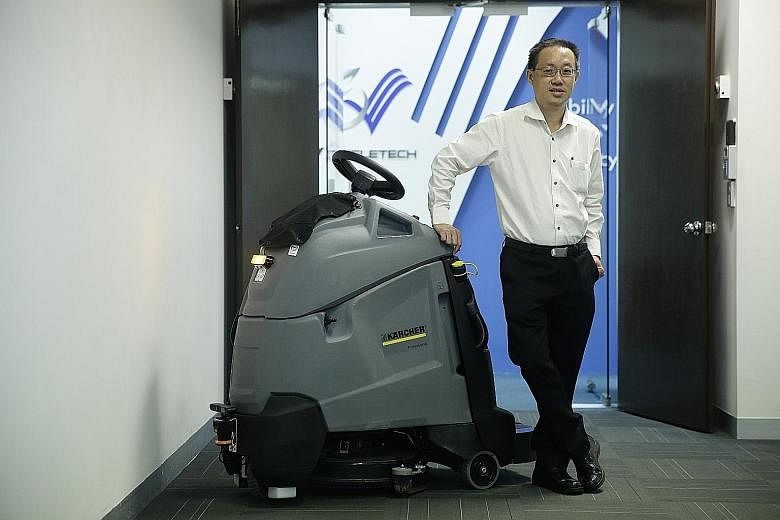Q Tell us more about the rebranding plans for the firm, which has been known as a specialist in location-based solutions.
A For the past 14 years, since the firm first started as V3 Teletech in 2002, we've been providing mobility and automation solutions, focusing on fleet management systems, workforce management and optimisation applications, and intelligent transportation systems.
These are targeted at industries such as logistics, municipal, construction, waste management and taxi services.
Our company's philosophy is offering " visibility, velocity and variability", the three Vs. Even with the name change on Sept 1, our vision remains.
To meet our customers' needs and help them to be future-ready, three years ago we expanded our business into developing robotics and industrial sensor automation, to complement our software development, and formed an engineering department to focus on that - one of the few SMEs to do so then.
We introduced our cloud-based robotics named the V3Transformer and the Sentient Eye, which uses sensor technology to elevate the work life of the workforce.
Q How does the firm's cloud-based robotics work?
A The V3Transformer was our first product, which transforms any manual surface maintenance machine into an autonomous, intelligent system.
V3 Smart Technologies has a patent for it, and interestingly, we also obtained a written opinion by the International Preliminary Examination Authority (a global body that carries out an initial check to see if an invention is new) that V3Transformer has been documented as being novel and inventive with industrial applicability worldwide.
The key component of the cloud robotics or V3Transformer technology is the intelligent robotic brain, which we retrofit onto any existing mechanical sweeper or scrubber in the cleaning industry.
We were glad to be hand-picked by Karcher, a German cleaning machines manufacturer, to incorporate our system to robotise its range of scrubbers and sweepers.
The technology encompasses powerful processes where the machine can do deep learning of the cleaning route process and capture historical cleaning routes, for instance.
The entire "brain" is supported by a sensor to detect obstacles and objects while the machine is moving automatically.
The visualisation camera also supports the intelligent brain by transmitting images of the surrounding area to the backend cloud robotics platform for analysis and monitoring purposes.
Firms can monitor their machines remotely, data can be captured wirelessly, so with robotics on the field, you are able to monitor and analyse performance effectively. Even if the robotic brain malfunctions, the cleaning machines can override it to be used manually.
The system raises efficiency and productivity, as machines can cover more area in an automated mode, especially in labour-intensive industries.
Q Besides the robotic brain, how can the Sentient Eye help cleaners or maintenance firms?
A As part of the Internet of Things, such systems can transform an existing normal bin into a smart bin.
Using sensor technology, the system can easily detect the level of fill of the rubbish bins and trigger an alert instantly, based on monitoring parameters, to get cleaners to attend to the site for clearing tasks.
Now it's labour-intensive work in shopping malls as cleaners have to check on all bins regardless of how empty they are.
The sensor system works on what we call a needs-collection basis or model, so the cleaners clear the trash only when the bin is filled at a defined percentage or level.
And we can assign tasks more efficiently.
We also expanded the use of this to contractors or big bin centres, to measure the level of rubbish.
So instead of trucks going to all sites to collect trash, they can be more efficient as they no longer have to go to half-filled compactors to pull trash out, which wastes time, effort and money.
The backend system will monitor these aspects.
Q Where is V3 Smart Technologies now with its new products?
A The V3Transformer was commercialised in the second quarter of this year, and the market pricing is less than $50,000 per machine for the complete solution, including three years of support for software maintenance and hosting.
We have almost $500,000 worth of contracts in our order book for this robotics system since the commercial launch.
International and local cleaning contractors already using the system include Ramky Cleantech Services and Avon Cleaning Service for their commercial buildings cleaning contracts.
We've just won an award on Nov 25 at the Asean ICT Awards, which were held in Brunei and recognise the best ICT achievements across the region.
We put forward the V3Transformer solution and won a silver award in the private sector category, which had more than 100 participating firms.
Q What are your future plans?
A We're keen on exploring anything related to being a Smart Nation using our technology and know-how.
For instance, we also have a car plate recognition system, part of our road map to provide a full suite of solutions in facility management.
The cleaning industry is only the start of the facility management industry.
Other aspects of managing a building include security, workforce scheduling and sensors to monitor various aspects in a building.
MORE ONLINE
Adrian Long explains how the technology works. Watch it at http://str.sg/4QMj


